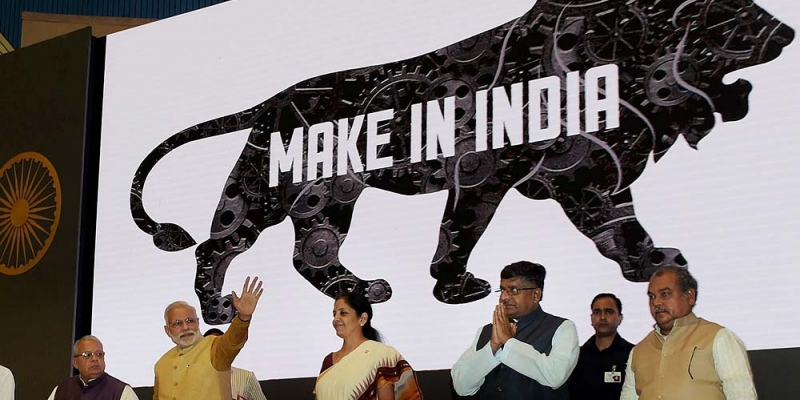Everything you wanted to know about Make in India Programme
Explore comprehensive insights on the Make in India programme, an initiative to boost manufacturing, foster innovation, and attract investments. Make in India has brought in a range of fresh initiatives, indorsing foreign direct investment, applying intellectual property rights and evolving the manufacturing sector. Learn about its objectives, key sectors, benefits, and how it's transforming India's economic landscape. Know more
Make In India Programme - Launched on September 25, 2014, Narendra Modi’s ambitious “Make in India” programme is meant to transform India into a global manufacturing hub in the world. Several steps have been taken by the Government of India to support this. Prime Minister Narendra Modi kicked off the much-touted Make in India programme on September 25, 2014, with the foremost objective of making India a global manufacturing hub, by promoting both multinational as well as domestic businesses to manufacture their products within the nation. Commanded by the Department of Industrial Policy and Promotion, the programme hopes to increase the contribution of the manufacturing section to 25% of the Gross Domestic Product (GDP) by the year 2025 from its existing 16%. Make in India has brought in a range of fresh initiatives, indorsing foreign direct investment, applying intellectual property rights and evolving the manufacturing sector.
New Processes:
The government has brought in several reforms to foster possibilities for getting Foreign Direct Investment (FDI) and foster business partnerships. Some initiatives have already been undertaken to alleviate the business environment from outdated policies and regulations. This reform is also aligned with parameters of World Bank's 'Ease of Doing Business' index to improve India's position on the same.
New Infrastructure:
As infrastructure is inherent to the growth of any industry, the government hopes to develop industrial corridors and develop smart cities with state-of-the-art technology and lightning-fast communication. Innovation and research activities are complemented by a steadfast registration system and better infrastructure for Intellectual Property Rights (IPR) registrations. Along with the development of infrastructure, the training for the skilled staff for the sectors is also being taken into account.
New Sectors:
‘Make in India’ has recognized 25 sectors to promote with the comprehensive information being shared through a communicating web-portal.1 The Government has enabled 100% FDI in Railways and eliminated restrictions in Construction.3 It has also recently augmented the cap of FDI to 100% in Defense and Pharmaceutical.
New Mindset:
Government in India has always been perceived as a regulator and not an organizer. This initiative proposes to change this position by introducing a paradigm shift in the way Government communicated with different industries. It will concentrate on acting as a partner in the economic development of the
country alongside the corporate sector. Since the commencement of “Make in India” programme in September 2014, FDI inflows of USD 77 billion including an equity inflow of USD 56 billion has been procured for the period October 2014 to March 2016. This represents about a 44% increase in FDI Equity inflows over the same matching period.
Zero Defect Zero Effect
In the words of Prime Minister Narendra Modi, “Let’s think about making our product which has 'zero defect'… and 'zero effect' so that the manufacturing does not have an adverse effect on our environment". Therefore, sustainable development in the country is being made conceivable by embracing high-quality manufacturing standards while minimizing environmental and ecological influence.
Some of the most notable development taken under “Make in India” programme are:
- GST has smoothened the procedural system with respect to taxation and also helped in bringing down the the production budgets.
- In the recent times, digitization has taken the center stage. The registration of the company and its survival has been made easier by a seamless web-based system.
- The refreshed Insolvency and Bankruptcy Code is meant to help you during bad days through a robust restructuring apparatus.
- Programmes like Jan Dhan Yojana and Prime Minister’s Jan Dhan Yojana help at financial inclusion of all the citizens.
- The term Foreign Direct Investment has been doing the rounds for a while now. Liberalization of Foreign direct investment has been brought about a considerable surge in the inflow of FDIs and has also helped in making India a liberated economy. The after effects are definitely affirmative due to job creations.
- Connectivity is crucial when it comes to expanding businesses. The Sagarmala programme and Bharatmala Pariyojana Programme hope to aid in that direction.
- Technology is still a distant dream in the rural areas of the country. However, now, with BharatNet making digital delivery of various services across the country has started.
- India is World’s No. 4 in terms of its volume to generate power from winds and World’s No. 6 in solar power generation.









